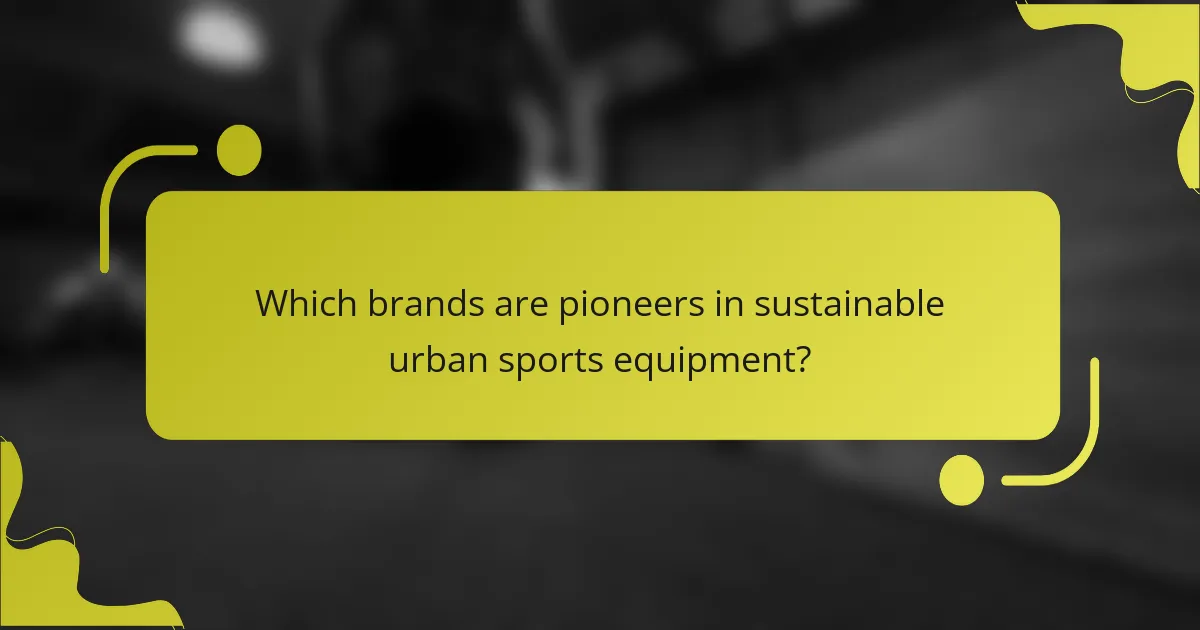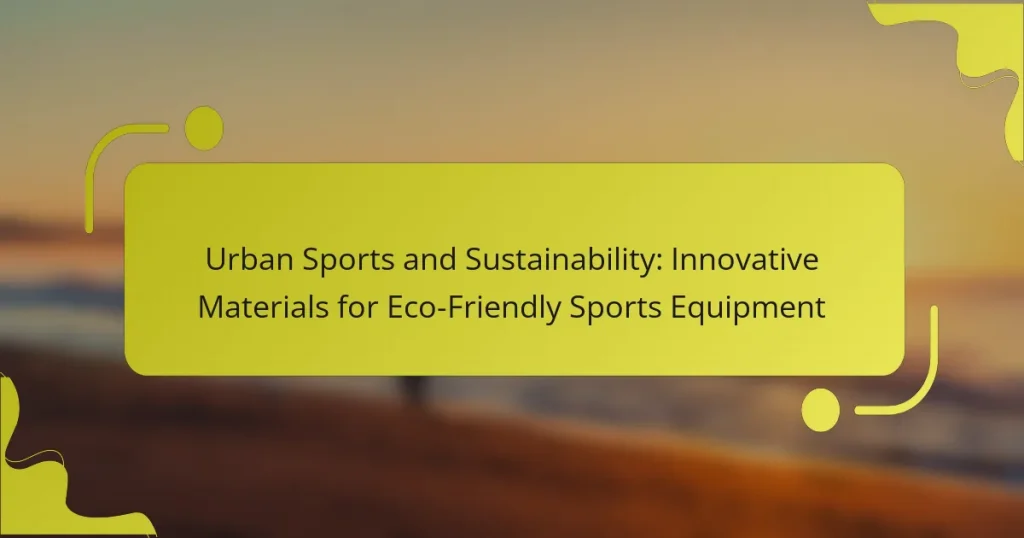Urban sports are increasingly adopting sustainable practices through innovative materials for eco-friendly equipment. This article explores how recycled components, biodegradable substances, and renewable resources are transforming skateboarding, parkour, and cycling. It addresses the challenges manufacturers face in sourcing sustainable materials and maintaining performance standards. Additionally, it highlights pioneering brands leading the way in merging urban sports with sustainability and examines consumer perceptions of eco-friendly sports gear.

How do innovative materials contribute to sustainable urban sports equipment?
Innovative materials significantly enhance the sustainability of urban sports equipment by reducing environmental impact. These materials often incorporate recycled components, biodegradable substances, and renewable resources. For example, using bio-based plastics can decrease reliance on fossil fuels. Additionally, advanced composites improve durability, leading to longer product lifespans and less waste. Eco-friendly coatings can also minimize harmful emissions during the manufacturing process. Overall, these innovations contribute to a more sustainable urban sports landscape.
What are the key eco-friendly materials used in sports equipment?
Key eco-friendly materials used in sports equipment include recycled plastics, natural rubber, bamboo, and organic cotton. These materials reduce environmental impact while maintaining performance standards.
Recycled plastics are often utilized for making water bottles and apparel, minimizing waste. Natural rubber serves as a sustainable alternative in footwear and mats, offering durability. Bamboo is lightweight and strong, frequently used in various sports gear. Organic cotton is favored for its low environmental footprint in clothing production.
These innovative materials contribute to sustainability in urban sports, aligning with eco-conscious consumer preferences.
Why is sustainability important in urban sports?
Sustainability is crucial in urban sports as it minimizes environmental impact while promoting healthier lifestyles. Eco-friendly sports equipment, made from innovative materials, reduces waste and carbon footprint. Sustainable practices enhance community engagement and foster a culture of responsibility among athletes. By prioritising sustainability, urban sports can lead to a more resilient and eco-conscious society.

Which urban sports are leading the way in sustainability?
Urban sports leading the way in sustainability include skateboarding, parkour, and cycling. These sports utilize innovative materials for eco-friendly equipment, reducing environmental impact. Skateboards made from bamboo and recycled plastics exemplify sustainable practices. Parkour emphasizes natural environments, promoting urban green spaces. Cycling benefits from lightweight, recycled materials in bike manufacturing, enhancing sustainability.
How do materials impact performance in urban sports?
Materials significantly impact performance in urban sports by enhancing durability, weight, and sustainability. Innovative materials, such as recycled plastics and natural fibres, improve equipment performance while reducing environmental impact. For example, lightweight composites increase agility and speed in sports like parkour and skateboarding. Sustainable materials contribute to the eco-friendly movement, appealing to environmentally conscious athletes. As a result, the choice of materials directly influences both performance and sustainability in urban sports.
What are the environmental benefits of using sustainable materials in sports?
Using sustainable materials in sports significantly reduces environmental impact. These materials minimize waste, lower carbon emissions, and conserve natural resources.
Sustainable sports equipment often incorporates recycled plastics, organic cotton, and bamboo. For instance, recycled plastics can decrease landfill waste by up to 30%. Additionally, using renewable resources like bamboo helps preserve forests and reduces deforestation.
Eco-friendly materials also enhance product lifespan, resulting in less frequent replacements. This durability translates to lower resource consumption over time. As a result, the overall ecological footprint of sports activities diminishes.

What challenges do manufacturers face in creating eco-friendly sports equipment?
Manufacturers face significant challenges in creating eco-friendly sports equipment. These include sourcing sustainable materials, ensuring performance standards, and managing production costs.
Sustainable materials often lack the durability or performance characteristics of traditional options. For example, biodegradable plastics may not withstand intense physical activity. Additionally, the initial costs of eco-friendly materials can be higher, impacting pricing strategies.
Manufacturers also struggle with supply chain logistics. Sourcing sustainable materials can be limited and inconsistent, complicating production schedules. Furthermore, consumer demand for eco-friendly products is rising, requiring manufacturers to innovate rapidly while maintaining quality and affordability.
Finally, regulatory compliance adds complexity. Manufacturers must navigate environmental regulations while ensuring that their products meet safety and performance standards. This balancing act can slow down the adoption of eco-friendly practices in the sports equipment industry.
How do costs compare between traditional and sustainable materials?
Sustainable materials often have higher upfront costs compared to traditional materials, but they can lead to long-term savings. For example, recycled plastics may cost 10-30% more initially, but their durability and reduced environmental impact provide significant value over time. Additionally, the market for eco-friendly materials is growing, which may lower costs as production scales.
What regulatory standards must be met for sustainable sports equipment?
Sustainable sports equipment must meet standards for materials, production processes, and end-of-life disposal. Key regulatory frameworks include ISO 14001 for environmental management and the Global Organic Textile Standard (GOTS) for textile products. Compliance ensures that products minimize environmental impact and promote sustainability. Additionally, certifications like the Forest Stewardship Council (FSC) validate responsible sourcing of materials. Meeting these standards enhances consumer trust and supports eco-friendly practices in urban sports.

Which brands are pioneers in sustainable urban sports equipment?
Pioneering brands in sustainable urban sports equipment include Patagonia, Adidas, and The North Face. These companies utilize innovative materials and sustainable practices to create eco-friendly products.
Patagonia focuses on recycled materials and fair labour practices, while Adidas has introduced shoes made from ocean plastic. The North Face emphasizes responsible sourcing and circular economy initiatives. These brands lead the way in merging urban sports with sustainability.
What unique attributes differentiate these brands in the marketplace?
Brands in the eco-friendly sports equipment market differentiate through unique attributes such as material innovation, sustainability certifications, and performance metrics. For instance, some brands utilize recycled plastics and organic fabrics, while others focus on biodegradable options. Additionally, certain brands may offer customizable equipment tailored to specific sports needs, enhancing user experience. Lastly, the commitment to social responsibility and fair trade practices further sets these brands apart in a competitive landscape.
How do these brands communicate their sustainability efforts?
Brands communicate their sustainability efforts through transparency, innovative materials, and community engagement. They often highlight the use of recycled or eco-friendly materials in their products, showcasing a commitment to reducing environmental impact. For instance, companies may share detailed reports on their sourcing practices and carbon footprint reduction initiatives. Additionally, many brands engage with their communities by promoting sustainability education and encouraging eco-friendly practices among consumers.

What are the consumer perceptions of eco-friendly sports equipment?
Consumer perceptions of eco-friendly sports equipment are increasingly positive, driven by sustainability awareness. Many consumers prioritise innovative materials that reduce environmental impact. Attributes such as durability and performance are essential, but eco-conscious buyers also seek transparency in sourcing and manufacturing processes. Brands that communicate their commitment to sustainability effectively gain consumer trust and loyalty.
How do purchasing behaviours vary across different regions?
Purchasing behaviours for eco-friendly sports equipment vary significantly across regions due to cultural attitudes, economic conditions, and environmental awareness. For example, urban areas in Europe show a higher demand for sustainable materials compared to regions with less environmental focus. In North America, consumers prioritise performance alongside sustainability, influencing their purchasing decisions. Emerging markets may exhibit growing interest in eco-friendly options as awareness increases. Factors like local regulations and community initiatives further shape these behaviours, emphasising the importance of regional context in the sports equipment market.
What factors influence consumer choices regarding sustainability in sports?
Consumer choices regarding sustainability in sports are influenced by factors like material innovation, environmental impact, and brand transparency. Consumers increasingly prefer eco-friendly sports equipment made from sustainable materials. The demand for innovative designs that reduce carbon footprints drives manufacturers to adopt greener practices. Social responsibility and ethical sourcing also play significant roles in shaping consumer preferences. As a result, brands that prioritise sustainability often gain a competitive edge in the urban sports market.
How can brands effectively educate consumers about sustainable options?
Brands can effectively educate consumers about sustainable options by showcasing the innovative materials used in eco-friendly sports equipment. Highlighting attributes such as biodegradability, recyclability, and reduced carbon footprint engages consumers. For example, brands can use storytelling to share the journey of materials from sourcing to production. Collaborating with influencers who advocate for sustainability can amplify these messages. Additionally, providing transparent information about the environmental impact of products builds trust. Engaging consumers through interactive campaigns, such as workshops or demonstrations, fosters a deeper understanding of sustainable choices.

What future trends are emerging in sustainable urban sports equipment?
Emerging trends in sustainable urban sports equipment focus on innovative materials and eco-friendly designs. Manufacturers are increasingly using recycled plastics and biodegradable composites to reduce environmental impact. Smart technology integration, such as tracking performance and sustainability metrics, is gaining traction. Additionally, modular designs are becoming popular, allowing users to replace parts instead of discarding entire products. This shift towards sustainability reflects a growing consumer demand for environmentally responsible sports gear.
How is technology shaping the development of eco-friendly materials?
Technology is revolutionising eco-friendly materials for sports equipment by enhancing sustainability and performance. Innovations such as bio-based polymers and recycled composites reduce environmental impact while maintaining durability. For instance, companies are developing equipment using plant-derived materials, minimising reliance on fossil fuels. Advanced manufacturing techniques, like 3D printing, allow for efficient material use and customisation, further promoting sustainability in urban sports. As a result, the sports industry is increasingly adopting these innovative materials to align with eco-conscious consumer preferences.
What role do collaborations play in advancing sustainability in sports?
Collaborations significantly enhance sustainability in sports by fostering innovation in eco-friendly materials. Partnerships among brands, athletes, and organisations drive the development of sustainable sports equipment, such as biodegradable or recycled materials. For example, companies are increasingly utilising plant-based composites to reduce environmental impact. These collaborations not only promote sustainable practices but also raise awareness among consumers about the importance of eco-friendly choices in sports. As a result, the sports industry can transition toward more sustainable practices, ultimately benefiting both the environment and the community.
What are the best practices for integrating sustainability into sports equipment design?
Integrating sustainability into sports equipment design involves using innovative materials and practices that minimise environmental impact. Key practices include selecting biodegradable materials, utilising recycled components, and optimising manufacturing processes for energy efficiency. Collaboration with eco-conscious suppliers enhances sustainability efforts.
Moreover, prioritising durability reduces waste by extending product lifespans. Engaging athletes in the design process ensures that performance needs align with sustainable choices. Regular assessments of environmental impact throughout the product lifecycle guide continuous improvement.
What common mistakes should brands avoid when promoting sustainable sports equipment?
Brands should avoid misleading claims about sustainability, neglecting transparency in sourcing, and failing to educate consumers. Misrepresentation of eco-friendly materials can damage credibility. Transparency builds trust; brands must disclose sourcing and production processes. Educating consumers on the benefits of sustainable sports equipment fosters informed choices and loyalty.




